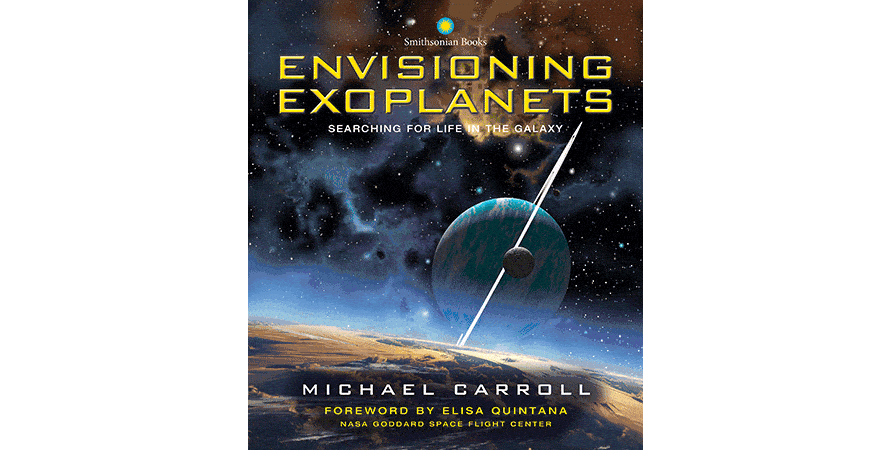Category: Nonfiction
Reviewed by: Loretta Hall
Title: Envisioning Exoplanets: Searching for Life in the Galaxy
Author: Michael Carroll
NSS Amazon link for this book
Format: Hardcover
Pages: 224
Publisher: Smithsonian Books
Date: October, 2020
Retail Price: $34.95
ISBN: 978-1588346919
Michael Carroll’s Envisioning Exoplanets is a feast for the eyes and the imagination. More than 200 spectacular images grace its pages, giving substance to the data, analyses, and speculations presented in the text. A few illustrations are images generated by ground- and space-based observatories, but the vast majority are vivid artworks created by the author and members of the International Association of Astronomical Artists. The science-based images are so realistic that foreword writer Elisa Quintana comments “at NASA we have to label them ‘artist concepts,’ because often a lot of people mistakenly believe they are real photographs.”
The book displays the incredible environmental variety among more than 4,000 exoplanets whose existence have been confirmed. They include rocky worlds whose surfaces are so hot that they are seas of lava, with ruby and sapphire vapors creating auroras in their skies. Other rocky planets are frigid worlds like the one nicknamed Hoth, whose surface temperatures hovers at 370 degrees below zero Fahrenheit. Some planets orbit their stars so closely that their years are measured in a few Earth-days or even Earth-hours. One orbits in a strange, elongated path in which the separation from its sun ranges from the Earth-Sun distance to only 0.03 times that distance. Some planets orbit two or even three stars, with pairings as strange as two stars that actually touch each other or as disparate as a white dwarf paired with a pulsar.
I was impressed by how much information scientists can glean from mere glimpses or inferences of exoplanets and yet how little they really know about those distant worlds. Take the descriptions of the planet Teagarden b for example. Its mass is nearly identical to Earth’s, its environment probably includes liquid water, and its daytime surface temperature is likely around 82 degrees Fahrenheit. “It is a strange, orange-tinted world with a year lasting only five Earth days,” Carroll writes. Those are amazing details for an object located 12.5 light years (nearly 75 trillion miles) away. Its similarity to Earth is considered to be remarkably high. Yet, astronomers can’t tell whether it has an atmosphere; but they estimate that probability at only 3 percent, based on their understanding of planetary science.
The book’s focus is exoplanets that may support life, so the descriptions are dominated by rocky planets or rocky moons of gas giants. Those that seem potentially habitable in the sense of our own world are rare. “Our survey of planets that would terrify everything from microbe to mammoth provides a key insight,” Carroll writes. “Earthlike worlds are hard to come by (and ones with active, living biomes are probably even more uncommon).”
But the author doesn’t stop there. The book’s final chapter examines the nature of life and what forms it might take in far different environments. “Even if life-bearing worlds are abundant in the universe,” Carroll writes, “odds are that their inhabitants may be less like us and more like slime mold or dandelions.” That’s a disheartening thought for those of us who hope for eventual contact with intelligent extraterrestrials.
I recommend this book for two reasons. Its explanations of various types of stars and planets are easy to understand and thought provoking. And its stunning images translate those theoretical concepts into visual reality that is more comprehensible than theory.
© 2021 Loretta Hall
Please use the NSS Amazon Link for all your book and other purchases. It helps NSS and does not cost you a cent! Bookmark this link for ALL your Amazon shopping!



















